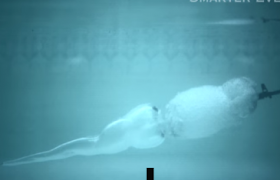
Implications for marine mammals of large-scale changes in the marine acoustic environment. Other contributions are from ship noise and fishing sonars Biological noise Many marine organisms can generate noise. Fishing activity The act of dragging a trawl across the seabed is an inherently noisy operation. Acoustic mapping of pelagic fish distribution and abundance in relation to a seismic shooting area off the Norwegian west coast. The noise of aircraft can couple into the water, particularly in the case of helicopters operating low over the surface of the water.

Impact of Anthropogenic Noise on Fish Behaviour and Ecology. It is the background of noise, typical of the location and depth where a measuring hydrophone is located, against which a signal,' such as the sound of a.

It excludes momentary, occasional sounds, such as the noise of a close-by passage of a ship or of an occasional rain squall. Impact of an acoustic stimulus on the motility and blood parameters of European sea bass (Dicentrarchus labrax L.) and gilthead sea bream (Sparus aurata L.) Mar. Abstract : By ambient noise we mean the prevailing, sustained unwanted background of sound at some spot in the ocean. doi: 10.1121/1.1461915.īuscaino G., Filiciotto F., Buffa G., Bellante A., di Stefano V., Assenza A., Fazio F., Caola G., Mazzola S. Ocean ambient sound: Comparing the 1960s with the 1990s for a receiver off the California coast. In addition, further studies are needed to reveal in detail the causes for the detected impacts.Īuditory masking behavior alteration marine organisms metabolism noise population composition recruitment.Īndrew R.K., Howe B.M., Mercer J.A., Dzieciuch M.A. Moreover, the scarcity of studies carried out with other species and with larval or juvenile individuals severely constrains the present understanding of noise pollution. However, since different sampling methodologies and unstandarized measurements were used and the effects of noise on marine organisms are dependent on the characteristics of the species and noise investigated, it is difficult to compare the reported results. Studies showed that anthropogenic noise can cause auditory masking, leading to cochlear damage, changes in individual and social behavior, altered metabolisms, hampered population recruitment, and can subsequently affect the health and service functions of marine ecosystems. In general, the studies about the impact of noise on marine organisms are mainly on adult fish and mammals, which account for more than 50% and 20% of all the cases reported. signal-to-noise ratio in the case of fluorescence-based signal. In this review, the source and the characteristics of noise in the sea, the significance of sound to marine organisms, and the impacts of noise on marine organisms are summarized. the sh sample, and images of the sensor were taken using a desktop scanner. Assuming that the uncorrelated measurement. The reasons for this agreement are discussed.With the growing utilization and exploration of the ocean, anthropogenic noise increases significantly and gives rise to a new kind of pollution: noise pollution. without 15-km smoothing would therefore be a factor of 7.5 times larger than the white-noise spectrum (2) of the 15-km smoothed SWOT data, S 1km(l) 1 S 1km(l) 15 cm2cpkm: (3) This white-noise spectrum of the unsmoothed onboard pre-processed SWOT data is shown by the blue dashed line in Fig. The magnitude of the laboratory breaker noise during continual wave‐breaking events was approximately 80 dB r e: 1 μ Pa 2/Hz at 1 kHz, which is essentially the same as observed during the continual bubble production that occurs with very high winds at sea. The average of the individual bubble events yielded a spectrum that slopes at about 5 dB/oct from 1 to 20 kHz, the same as the Knudsen wind noise spectra at sea.

Bubbles were observed in the 2 decades of frequency from 500 to 50 000 Hz. The noise is emitted when the bubble is within hundreds of micrometers or a few millimeters of the surface. Finn slips into a groove of going to mindless parties, getting sunburnt, and having hangovers. In general, they act as transient dipoles of duration from 2 to several milliseconds, with peak axial source strength of the order of tenths of pascals, at 1 m. Several species of bubbles have been identified. The waves are generated by a plunger, they propagate 17 m along a 1.2×1.2‐m water waveguide, and ‘‘spill’’ and create bubbles at the surface of a 3×3×3‐m anechoic cube of water. 3 Sources of ambient noise 12 3.1 Wind-sea noise 12 3.2 Precipitation noise 13 3.3 Shore/surf noise 13 3.3.1 Beach profile and beach face sediment 14 3.3.2 Noise sources in the surf zone 14 3.3.3 Sound propagation from the surf zone 16 3.4 Sediment transport noise 17 3.5 Aggregate extraction 18 3.6 Commercial shipping 18 3. Single coherent bubble contributions to the incoherent underwater noise of spilling breakers have been studied in an anechoic laboratory facility. A very low signal-to-noise dataset is analyzed to identify the presence of oscillatory signal and its frequency.


 0 kommentar(er)
0 kommentar(er)
